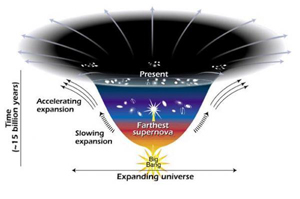What if Copernicus were wrong and the earth actually has a special place in the universe? Not some metaphysical, philosophical, supernatural special place, but just special in that the local environment is not the same as other local environments across the reaches of space? If that were so, then measurements on the apparent acceleration of ancient supernovae at the fringes of the known universe could be null and void. And, if those supernovae are not accelerating away from us, then there is no need to invoke the mysterious, invisible force known as dark energy.
In the late 1990s, there was a universal change in cosmology. The mathematics that described the origins of the universe in the Big Bang suddenly did not add up. Astronomers had noticed that the remnants of ancient stars that exploded billions of years ago, Type Ia supernovae, seemed to be moving away from us faster and faster.

Could the mysterious force thought to be accelerating the expansion of the universe be an illusion caused by our humility? (Credit: Image courtesy of NASA/STScI/Ann Feild)
These observations were not anticipated by Big Bang theory, if anything the universe should ultimately slow down and perhaps collapse back on itself. The evidence of these supernovae suggests that a force, dubbed dark energy, is resisting gravity and causing the aftermath of the Big Bang to accelerate.
Dark energy is thought to pervade the whole universe, a phenomenon as mysterious as the dark matter that also lies hidden across space. As with dark matter, scientists have no idea what it is or from where it originates. What they do know is that when they do their cosmic sums, dark energy accounts for 73% of the universe’s total energy, dark matter 23%, and the galaxies, stars, cosmic dust and all the planets representing just about 4%.
But a new study undertaken by physicists at Oxford University offers to shift the balance once more. Timothy Clifton, Pedro Ferreira, and Kate Land have suggested that rather than our physical position in the universe being irrelevant to the overall scheme of things, the Earth actually sits in a location of particularly low density. This, they explain, would distort our basic measurements of other regions of the universe, including observations of ancient supernovae.
The researchers explain that it should be possible to use measurements of the local red shift – the astronomical Doppler shift that stretches the wavelength of light from the stars as the universe expands – of objects and how this relates to their brightness and distance to show that in conflict with the Copernican principle, the Earth actually is in a physically, as opposed to metaphysically, special region of the Universe.
They suggest that the ongoing and future planned surveys of type Ia supernovae could focus on a particular red shift range (about 0.1–0.4), which will be ideally suited to determining whether their idea holds true over new distances without having to invoke dark energy to explain them.
Further reading
Phys. Rev. Lett., 101, 131302 (2008)
http://dx.doi.org/10.1103/PhysRevLett.101.131302
Dr Timothy Clifton homepage
http://www.jesus.ox.ac.uk/staff/clifton.php
Sciencebase, 6, 10, 2008
https://www.sciencebase.com/science-blog/cosmic-effort-sheds-light-on-dark-energy.html
Suggested searches
cosmology
Big Bang
supernovae
dark energy
redshift